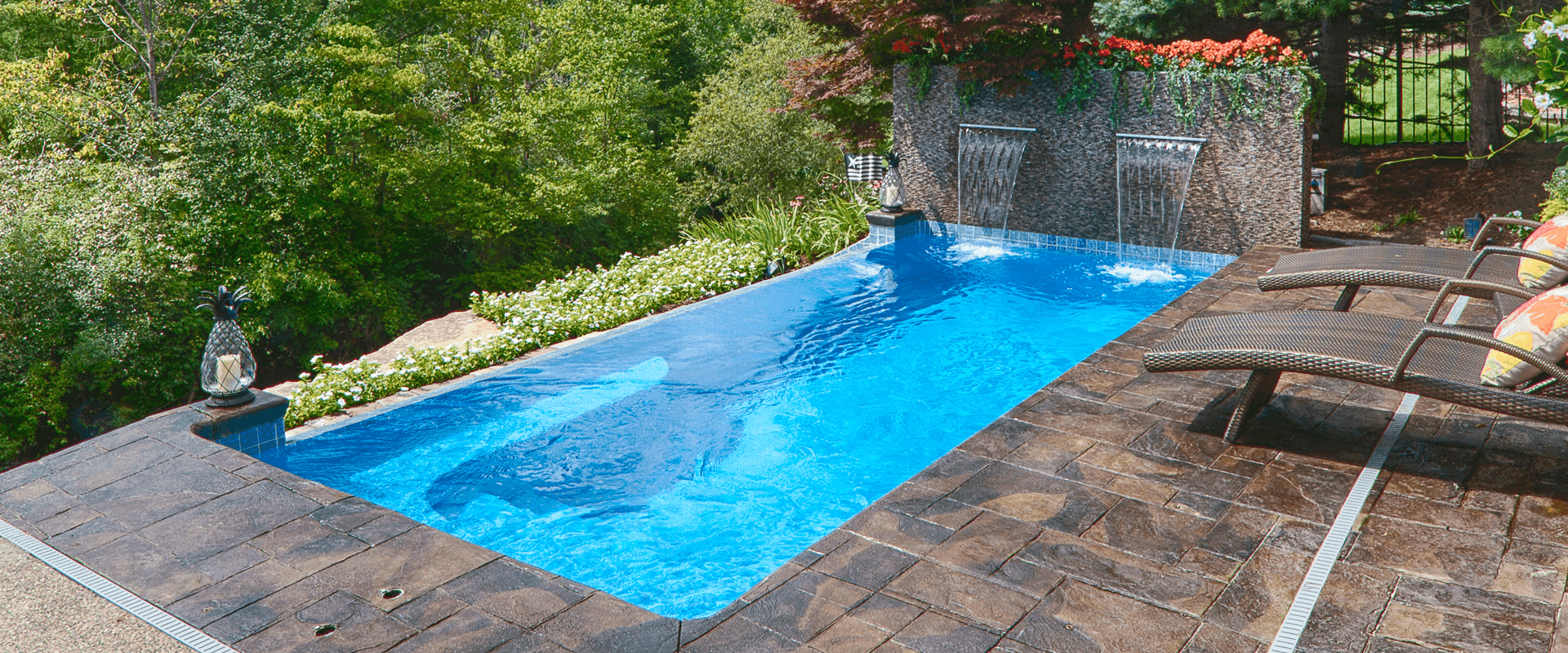877-929-7665
Five Essential Steps to Maintain Your Pool’s Finish
For many homeowners, the benefit of reduced maintenance responsibilities is influential in their decision to install a fiberglass pool in their backyard. The non-porous surface of a fiberglass pool significantly lessens the likelihood of algae growth and reduces the demand for chemicals to maintain water balance. This inherent characteristic of fiberglass pools substantially contributes to their appeal, offering homeowners more time to enjoy their aquatic sanctuary with less laborious upkeep. However, it’s crucial to understand that “lower maintenance” does not equate to “maintenance-free.” Maintaining your pool’s vibrant, smooth finish is just as important as keeping the water clear and inviting. While the allure of crystal-clear water is undeniable, the unseen balance of water chemistry plays a crucial role in preserving the integrity and appearance of your pool.
Step 1: Use a Stain and Scale Control Product Regularly
Even well-balanced water can carry minerals that deposit on your pool’s surface, leading to staining or scale buildup. A reliable stain and scale control product helps prevent fiberglass pool discoloration with chelating agents that can effectively shield your pool from calcium. In our experience, products like SC-1000 by Orenda and Scale & Stain Eliminator by Pool Stain Removers work well and should be part of your regular pool maintenance routine.
Step 2: Maintain Chlorine Levels Between 1-3 ppm
Chlorine protects your pool from harmful bacteria and algae. While chlorine is essential, too much can harm your pool’s finish. Keep free chlorine between 1 and 3 ppm. Beware of exceeding 5 ppm, as high chlorine levels can cause irreversible damage to your pool’s surface, leading to discoloration and degradation of the gelcoat.
Step 3: Avoid Calcium Hypochlorite
While calcium hypochlorite is common in various pool contexts for shock treatments, it poses risks for fiberglass pool surfaces due to its propensity to elevate pH levels and deliver a high dose of free chlorine. Liquid chlorine is a preferable alternative, offering a safer means to manage pool hygiene without the associated risks of calcium hypochlorite. Nevertheless, vigilance is required to prevent the adverse effects of excessive chlorine, ensuring the pool’s surface remains pristine.
Step 4: Keep pH Between 7.2 and 7.4
Maintaining a pH range between 7.2 and 7.4 keeps your chlorine effective and protects the pool’s surface. A pH above 7.8 can contribute to scaling and discoloration, while a pH that’s too low can lead to etching. Regular testing and adjustments help keep this critical pool maintenance parameter within range.
Step 5: Maintain Calcium Hardness Below 120 ppm
Fiberglass pools don’t need the same high calcium levels as concrete pools. Keeping calcium hardness less than 120 ppm helps prevent scale buildup and maintains the beauty of your surface finish. Do not add calcium-based products. If your water’s calcium hardness is greater than 120 ppm, use a chelating stain and scale control product to prevent scaling and discoloration.
Bonus Tip: Don’t Assume Your Pool Pros Know it All!
The pool maintenance industry is constantly evolving, with new products and refined best practices emerging regularly. As a pool owner, staying informed about these developments is beneficial to ensure your pool receives the best care possible.
Engage with your pool maintenance professionals and inquire whether they are familiar with specific parameters for fiberglass pools. Fiberglass pools are unique, and maintenance pros should treat them as such.
By following these five essential tips and staying on top of your water chemistry, you’ll protect your pool’s beauty and performance for years to come. Pool ownership is a journey. When you have the right knowledge, it’s a journey you can enjoy with confidence.
Looking for more information on fiberglass pool care? Explore Thursday Pools’ Ultimate Fiberglass Pool Maintenance Guide for a thorough look at everything you need to know.
And if you’re ready for personalized advice, connect with a local independent Thursday Pools dealer near you.
Frequently Asked Questions About Maintaining a Fiberglass Pool Finish
How do I protect my fiberglass pool’s finish?
Test your water often, keep chlorine between 1-3 ppm, maintain pH between 7.2-7.4, and use a stain and scale control product that chelates calcium. These steps prevent discoloration, scaling, and surface damage.
Why should I avoid calcium hypochlorite in a fiberglass pool?
Calcium hypochlorite raises pH and delivers a strong chlorine dose that can harm your pool’s gelcoat. Use liquid chlorine instead to sanitize safely.
What calcium hardness level works best for fiberglass pools?
Keep calcium hardness below 120 ppm. Higher levels can cause scale buildup and discoloration. Use a stain and scale control product that chelates calcium if you have naturally hard water with high calcium hardness, such as SC-1000 by Orenda or Scale & Stain Eliminator by Pool Stain Removers.
Does clear water always mean my pool water is balanced?
No. Water can look crystal clear but still be corrosive or scaling. Always test and adjust based on the LSI balance, especially as water temperature changes.
Should I rely on a pool service professional for water balance?
Stay informed and ask questions. Fiberglass pools require specific care, and not every pool professional knows the latest best practices. Double-check your pool’s water chemistry balance yourself regularly.
